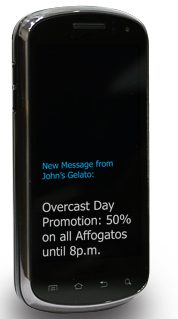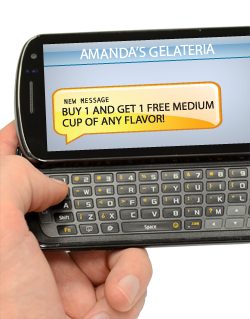Sometimes your business is so packed, there are no free tables, you have a long line, cash keeps pouring in and time seems to fly. Unfortunately, there are other times in which nobody seems to come to your establishment, time stands still and you wish you weren’t open at all. Your slow times can be caused by the location’s traffic patterns, your clients’ work or school schedules or the most uncontrollable element you will ever face – weather.
 While it’s normal to have peak hours and slower times in the foodservice industry; there are real-time marketing strategies out there that will draw foot traffic to your establishments during those sluggish hours – especially if they are caused by a cloudy day. As technologies develop at a frightening pace, the tools available have never been so affordable, effective and rapid. While traditional brochures and flyers need to be designed, printed and delivered, you ought to ask yourself if they are still the best way to reach your clients. To begin with, there’s a time lag to be accounted for – and if bad weather slows your foot traffic significantly, there’s no way you can address this issue using these traditional materials. Furthermore, how many people actually see or read your brochures and flyers? If you are mailing them, they’re very likely to end up in the trashcan immediately after the recipient opens his or her mail.
While it’s normal to have peak hours and slower times in the foodservice industry; there are real-time marketing strategies out there that will draw foot traffic to your establishments during those sluggish hours – especially if they are caused by a cloudy day. As technologies develop at a frightening pace, the tools available have never been so affordable, effective and rapid. While traditional brochures and flyers need to be designed, printed and delivered, you ought to ask yourself if they are still the best way to reach your clients. To begin with, there’s a time lag to be accounted for – and if bad weather slows your foot traffic significantly, there’s no way you can address this issue using these traditional materials. Furthermore, how many people actually see or read your brochures and flyers? If you are mailing them, they’re very likely to end up in the trashcan immediately after the recipient opens his or her mail.
If you want to be seen, you better be in the device people are glued to – mobile phones. Do you know how many times people look at their phones every day? 150 times per day approximately.1 With a sound strategy and execution, mobile marketing is your best bet to delivering effective communication in real time. If your foot traffic is slower than usual because of a cloudy day or below average temperatures, you can address this issue immediately by sending a time sensitive promotion via SMS messages (obviously, use good judgment and don’t invite people to drive when road conditions aren’t safe). Although mobile marketing is not the new kid on the block in technologies, it’s still the most efficient way to reach your target market in real time – and it’s more affordable than ever. If you complement mobile marketing strategy with a sound social media and inbound communication plan you will get the most value out of your money and time invested.
The statistics are astounding: 174 million Americans text every day. While 88 percent of emails go unopened, 84 percent of Facebook Newsfeed stories aren’t viewed and 71 percent of Tweets are ignored, 98 percent of all SMS and MMS messages are opened.1 Furthermore if you are targeting a younger demographic it’s important to understand that families may make decisions based on what the children want and the best way to reach them is also text messaging – 63 percent of teenagers text message every day.2 There are spam issues regarding SMS marketing of course, however if executed correctly, you could narrowly target your clients better than ever to deliver time sensitive promotions that will bring foot traffic during those slower hours. Here’s how to execute some of these ideas:
 Recognize Patterns: Before you jump into taking action, analyze the patterns in your business. It’s important to be somewhat scientific about this since you want to evaluate the effectiveness of your marketing strategies later on. Try to identify correlations between slow hours and different possible causes. For example take note of weather patterns. How do your sales do when temperatures are below average? What about rainy, cloudy or windy days? In addition, measure the sales during the regular busy hours and the regular slow hours, and make sure to measure sales by month. You might even be able to pull the average temperature per month as well and find patterns with sales.
Recognize Patterns: Before you jump into taking action, analyze the patterns in your business. It’s important to be somewhat scientific about this since you want to evaluate the effectiveness of your marketing strategies later on. Try to identify correlations between slow hours and different possible causes. For example take note of weather patterns. How do your sales do when temperatures are below average? What about rainy, cloudy or windy days? In addition, measure the sales during the regular busy hours and the regular slow hours, and make sure to measure sales by month. You might even be able to pull the average temperature per month as well and find patterns with sales.
Formulate a Strategy: Determine a budget and allocate accordingly. If your biggest goal is to draw more traffic into your establishment during slow hours, invest in tools that will help draw clients during those times – especially if they are caused by unpredictable weather. SMS marketing system cost can range from $15 to $95 a month depending on how many texts you’re planning on sending, and some providers will even allow for a free trial period or “Pay as you Go” plans. In addition, make sure to complement your mobile strategy with a strong social media presence and inbound communication strategy along with the other tools you may already have such as a website.
Next, plan your promotions ahead of time. You can put together a calendar with the promotions you plan on sending when you foresee slow hours. In addition, have a plan for those unforeseen slow days caused by bad weather. Perhaps your clientele drops significantly during an out-of-the-blue cloudy summer day. You can go even further and notice what products consumers prefer during those slow hours and formulate the promotion around that. This way you can put together a plan for each occasion: overcast day promotion, temperature below average promotion, windy day promotion, etc. Make sure to include your regular promotions in this schedule, since you probably already have some in place. If your campaign has capabilities to include image attachments, you can even include a tempting picture of the product.
Gather Numbers: As mentioned earlier, spamming issues are prevalent when talking about mobile marketing. Therefore, make sure clients understand what they’re signing up for. Avoid unclear sign-up methods such as fishbowls. They can be confusing and time-consuming, since you would have to enter the numbers into the system manually. Most mobile marketing providers have capabilities to gather numbers that expedite the process.
For example, customers can text an exclusive word if they wish to receive your messages and promotions. You can display this keyword and number in your establishment, social media sites and website. In addition, some providers offer Web forms to turn Web visitors into subscribers. You can also invite customers to a sweepstakes, since they would be easy to enter and set up. Finally, make sure that the mobile marketing provider has a clear opt-out process. You don’t want to frustrate your customers if they ever decide to stop receiving your texts.
Send Promotions: You should have the option to schedule texts if you know beforehand when you want to send promotions or coupons. However, SMS providers should also have the capability to send a massive text from your own cell phone; this way you don’t have to be near a computer to send out a campaign. This is ideal when dealing with unexpected slow times caused by some unasked-for clouds in the sky. In addition, you may be also able to communicate in realtime with customers who happen to be in the neighborhood with location-based services.
Limited-time deals will speed up the slow hours: Amanda’s Gelateria: Buy 1 and Get 1 FREE Medium Cup of any Flavor! Hurry, offer good only for the next 3 hours! You can also address the unexpected weather conditions and entice your customers to come for a product suitable for the weather: John’s Gelato: Overcast Day Promotion: 50% on all Affogatos until 8p.m. Pictures can be sent as attachments to lure customers. You may also encourage repeat customers with text coupons, weekly specials or events. You’ll appreciate the real-time communication. Since your call to action is immediate, people are more likely to respond immediately. On the contrary, if you’re mailing coupons, think about how much longer they take to be delivered and if they’re actually seen at all.

Measure Results: John Wanamaker, marketing pioneer from the 19th century, coined the phrase “Half the money I spend on advertising is wasted; the trouble is I don’t know which half.” Although this statement remains true for many of the traditional advertising tools, innovative technologies are helping identify the effectiveness of marketing efforts. Mobile marketing services typically allow you to track clicked links and see results that include new subscribers, opened messages and unsubscribed contacts. Furthermore, it is easy to keep a record of how many coupons or promotions are redeemed, since contacts will have to show the SMS text to qualify for the special offer.
If you recognize and analyze patterns, you can compare sales to determine how effective the promotions are. You may have the previous information of an overcast or rainy day in August, for example; therefore you can measure the difference after utilizing a mobile time-sensitive promotion. You can also make a month-to-month comparison to evaluate the effectiveness of the promotions or coupons. Remember that the more variables taken into account, the more scientific the approach becomes – allowing you to determine the effectiveness of your marketing efforts more closely.
While it’s normal to experience slow hours during days with not-so-great weather, a fresh and innovative marketing strategy will provide the flexibility and power to reach potential clients in real time – in addition to measuring the effectiveness. At the end of the day, you’ll be better equipped to deal with those unexpected slow times and generate more revenue.
Sources
1 Tepper, A. (2012) The Power of Text Message Marketing
http://mashable.com/2012/07/13/text-message-marketing-infographic/
2 Saumure, N. (2012) What Tech-Obsessed Teens Can Teach US About Marketing
http://www.business2community.com/marketing/what-techobsessed-teens-can-teach-us-about-marketing-infographic-0309188
